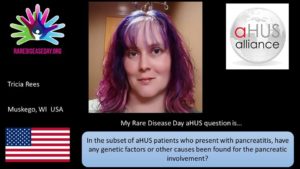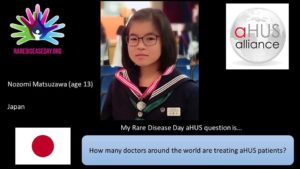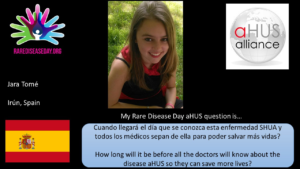Especially with very rare diseases such as atypical HUS, medical research and education efforts are keys to unlocking information that’s critical for diagnosis and for management of patient care. It’s important for all involved to work toward improved patient outcomes, since varied viewpoints create more insight to aid collaborative efforts. The aHUS Alliance, a group of patient organizations and advocates around the world, created a project with the 2017 international Rare Disease Day theme of ‘Research’. All patients, parents, caregivers, and aHUS families were invited to participate through outreach efforts across patient organizations and aHUS social media platforms, with the resulting project including global aHUS questions in 80 entries from 18 nations.
These four questions from the aHUS Alliance 2017 Rare Disease Day project offer questions on a common theme: wanting to know more about atypical HUS, its treatment, and how their medical case history fits within such a complex disease diagnosis.
From Rares Afrenie, ROMANIA
How can I understand in simple words, what is happening in my body during this disease?

Atypical hemolytic uremic syndrome is a collection of symptoms, which is why the term ‘syndrome’ appears in the disease name. A main feature of aHUS is the destruction of red blood cells, which explains use of the word ‘hemolytic’ since ‘hemo’ means blood and ‘lytic’ means disintegration of cells. Inclusion of the word ‘uremic’ means that rather than being filtered and removed, toxic waste products build up in the patient’s bloodstream, a sign of poor kidney function (renal disease) since waste products are normally excreted in urine. So why is ‘atypical’ part of the name of this very rare disease, estimated to affect 1 or 2 people out of a million? The more common form or ‘typical HUS’ usually happens when certain E. coli strains cause a gastrointestinal (GI) infection, which is sometimes known as D+ HUS ( to indicate HUS associated with diarrhea), and this is not a chronic disease like atypical HUS.
Diagnosis of aHUS can be very difficult as the initial vague symptoms can quickly become urgent, but those medical symptoms are common to many different other health conditions or diseases. Patients with atypical HUS most often have: blood and blood vessels which are affected, red blood cell counts that are low (anemia), a drop in platelet counts (used in clotting, thrombocytopenia is too few platelets) and tiny clots which may form anywhere in the body but often affect the kidneys and brain. Development of tiny clots (thrombi) can happen in different parts of the body to cause sudden or life-threatening conditions such as seizures, vision loss, stroke, cardiac issues, kidney failure and other serious medical situations. Genetic aHUS (also known as hereditary HUS, familial aHUS, or complement mutation-associated HUS) may occur at any age and accounts for an estimated 60% of all aHUS cases. Triggers for acquired aHUS may include bacterial and viral infections. Some drugs may trigger aHUS such as certain chemotherapeutics, antiplatelet drugs, immunotherapeutics, and include common medications such as oral contraceptives and anti-inflammatory drugs. Pregnancy-associated aHUS may develop during at various stages including post-delivery, with transplantation and underlying medical conditions such as autoimmune diseases also known to trigger aHUS activity.
In most cases aHUS is caused by uncontrolled activation of the complement system, part of the body’s immune system that we all are born with, and which usually acts in a controlled manner to defend against disease and inflammation to maintain good health. Atypical HUS affects patients of all ages, though its symptoms and their severity range widely, and aHUS frequently has a genetic component. A main characteristic of aHUS is the formation of tiny blood clots that systemically can occur throughout the body, known as ‘thrombotic microangiopathy’ (TMA). Raised lining of the small vessels and clots blocking them can shear red blood cells into pieces, which impacts their ability to carry oxygen from your lungs throughout the body. Platelets are an important component of your blood as these colorless cells help blood to clot, which stops cuts from bleeding when this clumping forms plugs. While helpful in case of injuries, random clot formation in blood vessels can block blood flowing as it should around the body and may cause life-threatening issues. If clots occur in the kidneys they can clog up the tiny blood vessels (glomerulus) that are a key part of the structure of the kidney’s filtration units (nephrons) and patients may need dialysis. If platelets break apart to form clots at an accelerated rate, patients can have low blood platelet counts (thrombocytopenia).
In some cases of atypical HUS, organs other than the kidneys might be most impacted. The term ‘extra renal involvement’ indicates disease activity that may affect organs other than kidneys, such as heart, lungs, GI tract, eyes, skin, or brain). This can make diagnosis of atypical HUS even more complicated, as physicians may encounter challenges when attempting to piece together facts and gain an accurate view of diagnosis and treatment. Patient care can be very complex when there is overlap, or when another disease state must be treated at the same time. Sometimes thrombotic microangiopathies (TMAs) are induced by or happen with an underlying medical condition such as cancer or autoimmune disorders (with aHUS secondary to SLE or lupus nephritis), or it may occur after stem-cell (HSCT) or organ transplantation (TA-TMA). Diagnosis of ‘Secondary TMAs’ is difficult and aHUS might trigger due to infections or another medical condition, be associated with pregnancy or delivery, or become activated by certain drugs, understandably with treatment needs focused on the cause or background disease.
Supportive care for aHUS patients includes plasma infusion or plasma exchange (also called apheresis or plasmapheresis), with dialysis as needed for kidney injury or renal failure. While patient responses to plasma therapies may be mixed, it’s widely available around the globe and therefore often used as a first line medical treatment due to this broad availability. Currently eculizumab is the only approved therapeutic drug for treating patients with aHUS, but eculizumab is not available in all nations and drug access may be restricted by governmental regulations by country or healthcare policy. Atypical HUS presents very differently in each patient, so while patient education and family support is very important, only medical professionals can work effectively with patients and families to determine the appropriate diagnosis and a personalized treatment plan. Read more on this topic: Is it aHUS? Perhaps it’s TTP, STEC-HUS, or Another TMA.
From Tricia Rees, Muskego WI USA
In the subset of aHUS patients who present with pancreatitis, have any genetic factors or other causes been found for the pancreatic involvement?

Rare disease patient care can be very complex when there is overlap, or when another disease state must be treated at the same time. A main characteristic of aHUS is the formation of tiny (micro) blood clots (thrombi) that systemically can occur throughout the body and affect the blood vessels (angiopathy). Known as ‘thrombotic microangiopathy’ or TMA, these tiny blood clots can cause damage to any organ or body system, since blood flows everywhere throughout the body. According to the Alexion aHUS education booklet “A Caregiver’s Journey”, 50% of all aHUS patients experience kidney complications, 48% have neurologic symptoms (confusion, stroke, seizure), 43% have cardiovascular complications (heart issues, high blood pressure, blood clot) , and 37% of patients experience gastrointestinal (GI tract) issues such as abdominal pain, diarrhea, colitis, or naseua/vomiting.
One of the organs considered part of the GI tract and which might be impacted is the pancreas, a large gland near the start of the small intestine. It secretes digestive juices (enzymes) to join with bile from the liver to help your body digest food. Additionally, the pancreas also releases insulin into the bloodstream to help regulate the sugar (glucose) it takes from your diet to turn into energy. Pancreatitis is an inflammation of the pancreas. A challenging area for physicians would be determining if an inflammation in the pancreas triggered the uncontrolled complement activation associated with aHUS. It could be that thrombotic microangiopathy (systemic tiny clots also called TMA) caused issues within the pancreas to trigger pancreatitis, and TMA is one hallmark of aHUS. Either way and whether aHUS is primary or secondary, patients and physicians must deal with medical issues and treatment plans for both pancreatitis and atypical HUS.
There are a few case studies published for patients for presenting with atypical HUS and pancreatitis. A 71 year old patient presented with pancreatitis was reported in one aHUS case study, but eventually it was determined that the blood supply to the colon additionally was affected (ischemic colitis) and there was some evidence of skin involvement as well. This study noted that 20% of aHUS patients have no kidney involvement, which was the case with this particular patient, but no mention was made of genetic testing nor was any variant listed. Another case study was presented at a hematology conference in Atlanta in 2015, that of a 52 year old patient who presented with abdominal pain and jaundice after an endoscopic procedure which listed acute pancreatitis as a possible complication. In that situation, a kidney biopsy confirmed TMA activity and atypical HUS was diagnosed, but again without mention of genetic factors.
Sometimes it’s difficult to find information regarding atypical HUS, and a few references can be found doing research reviews for the general topic of thrombotic microangiopathy or within articles on complement diseases. In the case of Complement in Pancreatic Disease—Perpetrator or Savior?, we find the statement that the “the complement cascade is tightly regulated and controlled by complement regulatory proteins (CRegs).” Membrane Cofactor Protein, MCP (CD46) would fall within this category. Under the heading of ‘Complement as a Main Pillar of Innate Immunity’ and in the subsection ‘Complement Activitation’ is the statement, “Extrarenal manifestations have been reported more commonly in CFH-autoantibody–mediated disease, with 23.5% having seizures and 23.1% developing pancreatitis.” (See also Table 9). Noted in research by Kavanagh D et al (2013), “Mutations in MCP (CD46) are found in approximately 10% of patients with aHUS” and that “Mutations in MCP (CD46) are found in approximately 10% of patients with aHUS”.
How might genetics play a role in such situations for aHUS issues, management and treatment? A brief synopsis of a case was reported at the NFK 2016 Spring Clinical Meeting (abstract #193) “Atypical Hemolytic Uremic Syndrome in a Patient with Acute Pancreatitis”, involving a 28 year old patient mentioned as having a combination of all three factors: atypical HUS, a genetic factor (MCP, CD46), and pancreatitis. “Decreased CD46 expression is seen in patients heterozygous for mutations in membrane cofactor protein (MCP), a complement regulatory protein that serves as a cofactor for cleavage of C3b and C4b. Two previous cases of atypical HUS have been reported in patients with heterozygous MCP mutations. Further genetic testing is indicated but has not been done in our patient yet due to lack of insurance.”
At the core of that last sentence is a statement that has ‘ripple out” impact, since not only is there a lack of funding for atypical HUS research but patients and their families often must pay the full cost and high expense of genetic testing. For atypical HUS patients, lack of access to affordable genetic testing remains an issue. As time goes on, research and medical advancements may join with genetic screening to provide a format of more personalized medicine to include tailored approaches to aHUS treatment and disease management. Research and better understanding of disease diagnosis and mechanisms would benefit greatly by genetic testing, but financial restrictions limit this at present.
From Nozomi Matsuzawa, JAPAN
How many doctors around the world are treating aHUS patients?

This is an excellent question, but one without a definitive answer since exact number of atypical HUS patients is up for interpretation. In Comprehensive Genetic Analysis of Complement and Coagulation Genes in Atypical Hemolytic Uremic Syndrome (2014, Bu F. et al) it is stated, “The prevalence of atypical HUS (aHUS) is estimated at 1 per 2 and 1 per 3.3 million children in the United States and Europe, respectively.” While that research quote specifically mentions children, other articles that do not mention aHUS patient age estimate atypical HUS patient populations at either 1 patient per million, or 1 to 2 aHUS patients per million population. When we realize that aHUS was first mentioned in medical literature by Conrad von Gasser just over 60 years ago, and that aHUS diagnosis is both difficult and complex, it becomes clearer to see why no firm patient numbers are stated in the literature. If aHUS patient numbers are only estimated, how might we expand on that to estimate the number of physicians around the world who are treating aHUS patients?
Patients may be referred by their primary care doctor to a physician with special medical training in areas such as: nephrology (kidney or renal diseases), hematology (blood disorders), immunology (immune issues, to include the complement system), or other specialty area (oncology or hem-onc for example). Since aHUS can be an inherited condition passed down in the family (genetic HUS or familial aHUS), sometimes geographic locations can have several aHUS cases grouped together. Otherwise, aHUS is so rare that most doctors never diagnose or treat a single case of atypical HUS in their medical careers. Exact numbers of aHUS patients are difficult to determine, but this mathematical approach might help determine an estimated worldwide number of aHUS cases. Currently the 2017 world population clock indicates about 7.5 billion people on earth, and aHUS literature refers to an estimated 1 to 2 atypical HUS patients per million population. Given that 7.5 billion people is equivalent to 7500 million, statistically there could be an estimated 7,500 to 15,000 people around the world with atypical HUS. Due to family inheritance of genetic factors among some aHUS patients, logic leads to the possibility of some so-called geographic ‘aHUS hotspots’ or regions with a small concentration of atypical HUS patients likely treated by the same specialty practice or physician in their region.
From Jara Tomé & family, Irún SPAIN
How long will it be before all the doctors know about the disease aHUS so they can save more lives?

In the last 10 years, there have been great strides in medical advancements and in use of the internet to encourage joint research and to aid access to information. Research in the field of complement mediated kidney diseases such as aHUS has experienced great growth in the past few years, particularly since 2011 when eculizumab was approved to treat patients with atypical HUS. Much more remains to be done, so much more remains to be discovered and shared.
As far as patients and aHUS families are concerned, the day when all physicians know about atypical HUS cannot come soon enough. We’ve seen an increase of knowledge gained from international research teams, and we’re heartened that there have been several key documents created by such global teams in the last three years. About 50 researchers and clinicians gathered to create Atypical hemolytic uremic syndrome and C3 glomerulopathy: conclusions from a “Kidney Disease: Improving Global Outcomes” (KDIGO) Controversies Conference, which was released in December 2016 and is a comprehensive document that includes recommendations regarding diagnosis, treatment, and management. The aHUS Alliance was honored to be invited to this KDIGO conference and to attend as participants. In 2014 the global pediatric community charged some of top aHUS researchers and clinicians to create a document, An international consensus approach to the management of atypical hemolytic uremic syndrome in children, that serves to guide physicians who treat young aHUS patients.
We appreciate that clinicians and researchers in several nations have begun holding conferences and meetings with the express purpose of sharing information and creating physician education resources and reference documents. Nationwide retrospective studies have been done in countries as varied as Norway, and we have begun to see a wide global and geographic spread to efforts, such as the clinical guidelines created for Korea. Physician education and outreach has many facets, to include rare and genetic non-profits as well as medical conferences in the fields of nephrology, hematology, and immunology. Industry efforts include stakeholders from biotech and pharma arenas have begun to take shape as well.
It will take all people and organizations working together to grow information, participate with bringing new aHUS therapeutics to clinical trial, and encourage efforts and opportunities that can promote better outcomes for atypical HUS patients. It will take creative efforts that connect various areas of information together with patient insights, such the joint effort An innovative and collaborative partnership between patients with rare disease and industry-supported registries: the Global aHUS Registry. Count on the aHUS Alliance to work toward a brighter future, working as collaborative partners, in hopes to save more aHUS lives.


